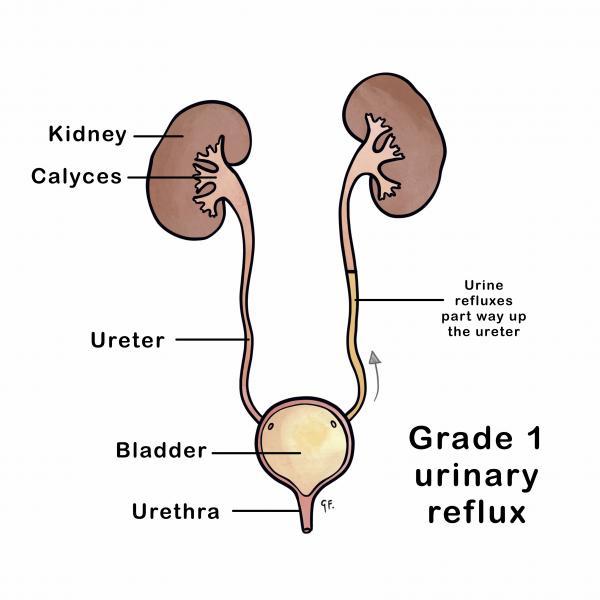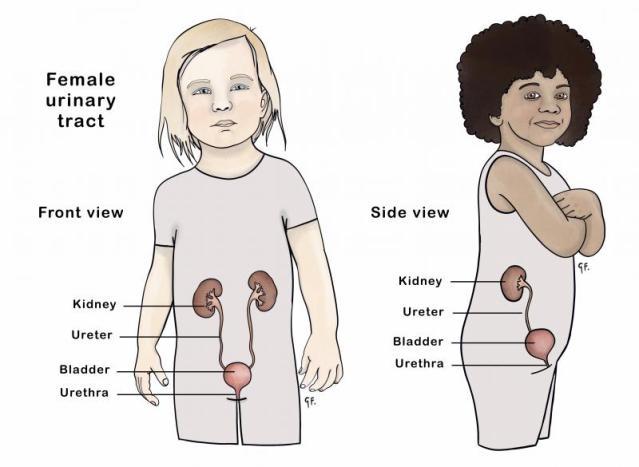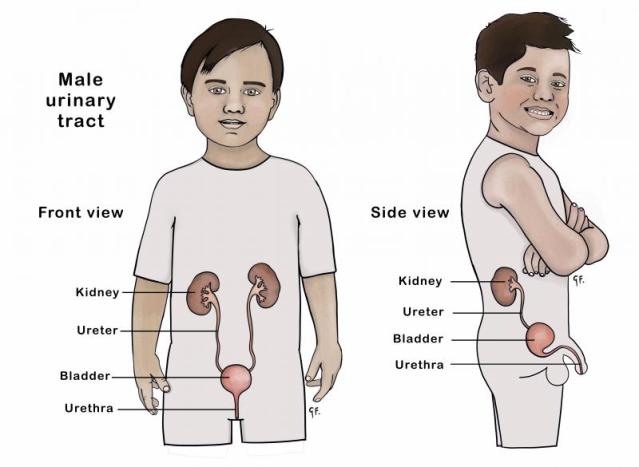What is an MCU?
An MCU is an x-ray test of the bladder as it fills and empties. It checks to see if the urine is flowing backwards from the bladder up towards the kidneys.
The test will take place in the radiology department of your hospital, or at another radiology centre.
Why a child may need an MCU
Your baby or child is having a micturating cysto-urethrogram (MCU) to find out if they have urinary reflux (backflow of urine from the bladder to the kidneys).

If your child is a boy, they may also have an MCU to check for an obstruction of the urethra.
How the urinary tract works
The urinary tract is the kidneys, ureters, bladder, and urethra.
The kidneys filter and remove waste and water from the blood to produce urine. The urine travels from the kidneys down 2 narrow tubes called the ureters. The urine is then stored in the bladder.
When your child does a wee, urine flows out of the body through the urethra, a tube at the bottom of the bladder. The opening of the urethra is at the end of the penis in boys and in front of the vagina in girls.

Front and side view of the female urinary tract.

Front and side view of the male urinary tract.
Preparing for an MCU
Some radiology departments may recommend antibiotics around the time of the test to prevent urinary infection. You will get instructions about this from your radiology department, or from the health professional who referred your child for the test.
Your radiology centre might give medicine to make your child sleepy. If healthcare staff do offer this medicine to your child, they will give you instructions about when your child needs to stop eating and drinking before the test.
What happens during an MCU
Your child might have some medicine
Some radiology centres will give a medicine to make your child sleepy before the procedure. Or, they might use a medicine your child breathes (nitrous oxide) during the procedure.
Your child lies on an x-ray table or cradle
- your child empties their bladder (if toilet-trained) and lies on an x-ray table
- your child may lie in a cradle so they can be gently restrained for their safety and to make the test quicker
A health professional puts in a catheter and fills the bladder with dye
- a health professional will clean the area around the opening of the urethra (the tube from which urine passes out of the bladder) with a mild antiseptic
- then they insert a catheter (a soft thin plastic tube) up through the urethra and into the bladder
- the catheter connects to a bottle of contrast (dye)
- the bladder is slowly filled with the dye
- the dye allows the bladder to be seen on x-rays
The doctor or x-ray technologist takes x-ray pictures while your child is weeing
- infants not toilet-trained will wee around the catheter when the bladder is full
- older tamariki (children) find it harder and require gentle encouragement to wee on the table
- the doctor, or x-ray technologist, will take x-ray pictures while your child is weeing
- the doctor checks these - if they are OK, they remove catheter
- the solution is washed off before a final x-ray
Does an MCU hurt?
Putting in the catheter can be uncomfortable, more so for boys because of their longer urethra. The health professional will use a lubricating gel to make it easier to put the catheter in. In older boys, local anaesthetic jelly can make the procedure easier.
Although having the catheter put in is uncomfortable, the x-ray is painless. Tamariki do find having a full bladder uncomfortable, but this goes away when they empty their bladder.
Preparing your child for an MCU
Many medical procedures or tests can be frightening for tamariki. To help your child feel more comfortable or reassured you can try the following.
Bring comforters or any toys that will reassure your child
A dummy (pacifier) for babies (if they normally suck on one) can be very soothing.
It is also helpful to bring something that will catch your child's interest and help them to focus on something else during the procedure. This could be a book that has an element of surprise or requires your child's concentration such as:
- a 'pop up' book
- a 'Where's Wally?'book
- an 'I spy' book
See some other suggestions for helping your child manage their treatment or procedure.
Helping Your Child Manage Their Treatment
Play specialists can help
Many hospitals have play specialists. Their job it is to help explain these tests to your child. Play specialists use play to show your child what is going to happen and ways to help them cope.
Watching a video can help
If your child is old enough, ask if your hospital's x-ray or children's department has a video explaining MCUs. It may help your child to watch this. Your local branch of Kidney Kids may also be able to help with this.
You can stay with your child
You will be able to stay with your child for the test. Your presence can help reassure your child.
Pregnant mothers cannot stay during the test, and in this case fathers or someone else familiar to your child can be there.
After effects from an MCU
There are usually no side effects from this test. Some tamariki feel a mild burning while weeing for a short time afterwards (sometimes a day or two). Encourage your child to drink plenty of fluids and this will pass quickly.
In rare cases, tamariki can have difficulty emptying their bladder. If your child has this problem, get them to wee while sitting in a warm bath.
Very rarely, your child may develop a UTI after an MCU.
Urinary Tract Infection In Children
Results of an MCU
The x-ray doctor (radiologist) will examine and interpret the x-ray films and send a written report to your health professional. This usually takes several days. Sometimes the radiologist will be able to discuss the results with you at the time of the examination.
Acknowledgements
Urinary tract anatomy illustrations and urinary reflux illustration by Dr Greta File. Property of KidsHealth.
